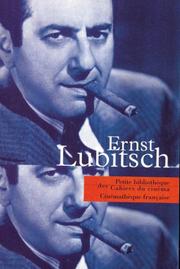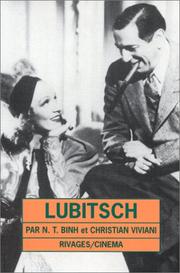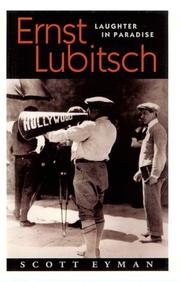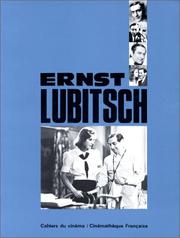| Listing 1 - 10 of 22 | << page >> |
Sort by
|

ISBN: 9782866424510 2866424514 Year: 2006 Publisher: Place of publication unknown Cahiers du cinéma/Cinémathèque française
Abstract | Keywords | Export | Availability | Bookmark
 Loading...
Loading...Choose an application
- Reference Manager
- EndNote
- RefWorks (Direct export to RefWorks)
Motion pictures --- Cinéma --- History --- Histoire --- Lubitsch, Ernst, --- Lubitsch, Ernst
Book
ISBN: 9789616417846 Year: 2014 Publisher: Ljubljana : Slovenska Cinematheque,
Abstract | Keywords | Export | Availability | Bookmark
 Loading...
Loading...Choose an application
- Reference Manager
- EndNote
- RefWorks (Direct export to RefWorks)
The contributions collected in this book examine Lubitsch's best Hollywood pictures from the 1930s and '40s -- Trouble in paradise, Design for living, Ninotchka, To be or not to be, and Cluny Borwn -- to demonstrate that comedy, at its best, is not merely a matter of providing comic relief.
Book
ISBN: 0882010077 Year: 1975 Publisher: New York : Darien House,
Abstract | Keywords | Export | Availability | Bookmark
 Loading...
Loading...Choose an application
- Reference Manager
- EndNote
- RefWorks (Direct export to RefWorks)
Lubitsch, Ernst, --- Ninotchka (film) --- Lubitsch, Ernst, --- Criticism and interpretation. --- Critique et interprétation --- Ninotchka (Motion picture)
Book
ISBN: 023105680X 9780231056809 0231056818 9780231056816 Year: 1983 Publisher: New York Columbia University Press
Abstract | Keywords | Export | Availability | Bookmark
 Loading...
Loading...Choose an application
- Reference Manager
- EndNote
- RefWorks (Direct export to RefWorks)
Lubitsch, Ernst, --- Criticism and interpretation --- Critique et interprétation --- CDL --- 791.471 LUBITSCH --- Cinema films --- Directing --- Lubitsch, Ernst - Critical studies --- Criticism and interpretation. --- Lubitsch, Ernst

ISBN: 2869304226 9782869304222 Year: 1991 Volume: 26 Publisher: Paris : Rivages,
Abstract | Keywords | Export | Availability | Bookmark
 Loading...
Loading...Choose an application
- Reference Manager
- EndNote
- RefWorks (Direct export to RefWorks)
Lubitsch, Ernst, --- Criticism and interpretation --- Criticism and interpretation. --- Critique et interprétation. --- CDL --- 791.471 LUBITSCH --- Lubitsch, Ernst --- 1892-1947

ISBN: 0801865581 Year: 2000 Publisher: Baltimore Johns Hopkins university press
Abstract | Keywords | Export | Availability | Bookmark
 Loading...
Loading...Choose an application
- Reference Manager
- EndNote
- RefWorks (Direct export to RefWorks)
Motion picture producers and directors --- Producteurs et réalisateurs de cinéma --- Biographies --- Lubitsch, Ernst, --- 791.471 LUBITSCH --- Berlijn --- Duitsland --- film --- filmgeschiedenis --- filmregisseurs --- Hollywood --- komedies --- Lubitsch Ernst --- musicals --- twintigste eeuw --- Verenigde Staten --- Lubitsch, Ernst
Book
ISBN: 9791023904338 Year: 2021 Publisher: Nantes : Capricci,
Abstract | Keywords | Export | Availability | Bookmark
 Loading...
Loading...Choose an application
- Reference Manager
- EndNote
- RefWorks (Direct export to RefWorks)
La comédie existe toujours, la cause est entendue, mais c’est véritablement de 1918 à 1968 que son programme s’est accompli dans le contexte hollywoodien. Singulière et plurielle – d’où le titre de ce livre -, la comédie américaine connaît un grand nombre d’espèces (sophistiquée, romantique, screwball, de remariage…) et le genre a lui-même si bien évolué que l’on a pu parler à partir des années 1950 de « seconde comédie américaine ». Katharine Hepburn et Cary Grant, Marilyn Monroe et Jack Lemmon, Ernst Lubitsch et Howard Hawks, Billy Wilder et Blake Edwards, Ben Hecht et Charles Lederer sont quelques-unes des figures qu’on croisera dans ce livre, au milieu de tant d’autres, actrices et acteurs, cinéastes et scénaristes – célèbres ou non. Mais ce sont avant tout les films qui se situent au cœur de ce voyage personnel, initiatique ou rétrospectif, où le rire conduit au bonheur et à la joie, sans pour autant oublier l’anarchie et la cruauté d’un genre plus surprenant qu’on ne le croit.
Comedy films --- Comédies (cinéma) --- Films comiques --- Edwards, Blake --- Lubitsch, Ernst --- Edwards, Blake, --- Lubitsch, Ernst, --- Comédies (cinéma) --- Comedy films - United States - History and criticism

ISBN: 2866420357 9782866420352 Year: 1985 Publisher: Paris : Cahiers du cinéma La cinémathèque française,
Abstract | Keywords | Export | Availability | Bookmark
 Loading...
Loading...Choose an application
- Reference Manager
- EndNote
- RefWorks (Direct export to RefWorks)
Motion picture producers and directors --- Producteurs et réalisateurs de cinéma --- Biography. --- Biographies --- Lubitsch, Ernst, --- Biography --- Lubitsch, Ernst --- Bernard Eisenschitz et Jean Narboni --- film --- filmregisseurs --- Lubitsch Ernst --- Verenigde Staten --- Duitsland --- 791.471 LUBITSCH --- Producteurs et réalisateurs de cinéma --- filmgeschiedenis --- CDL --- Motion picture producers and directors - United States --- Motion picture producers and directors - Germany - Biography --- Cinéma --- Lubitsch, ernst (1892-1947) --- Allemagne --- Etats-unis
Book
ISBN: 9780231186452 9780231186445 Year: 2018 Publisher: New York : Columbia University Press,
Abstract | Keywords | Export | Availability | Bookmark
 Loading...
Loading...Choose an application
- Reference Manager
- EndNote
- RefWorks (Direct export to RefWorks)
Ernst Lubitsch's sophisticated, elegant, and stylish films of the 1930s and 1940s are often credited with creating the genre of the classic Hollywood romantic comedy. Famed for the "Lubitsch touch" and his distinct comedic style particularly when it came to romance and sex and American hypocrisy around them. Lubitsch's films influenced and won the admiration of his fellow directors, including Welles, Hitchcock, and most notably Billy Wilder. And, while he is now best known as the director of such films as Ninotchka, The Shop Around the Corner, and To Be or Not To Be, much of his work and his name is less well known. In this book, Joseph McBride, the author of best-selling biographies of Steven Spielberg and Frank Capra, reconsiders Lubitsch's place in film history and reminds us of the genius of and the many pleasures of his film. In How Did Lubitsch Do It? (the title is a play on a sign that was in Billy Wilder's office) McBride examines all of Lubitsch's films beginning with his work in Germany where he became known as "The D.W. Griffith of Europe" for his historical epics as well as being celebrated for his comedies. McBride then considers Lubitsch's work in Hollywood and how his films reflected his amused indulgence of human behavior and a celebration of un-American virtues such as the joys of adultery and serial philandering while depicting marriage in a more realistic way. McBride's discussions of Lubitsch's films answer the question asked in the book's title to explain "The Lubitsch Touch" and the endlessly inventive and fresh ways the director found of telling stories, as well as his distinctive style, his handling of character, and his ability to strike the right tone in his films.
Book
Year: 1968 Publisher: New York : Dutton,
Abstract | Keywords | Export | Availability | Bookmark
 Loading...
Loading...Choose an application
- Reference Manager
- EndNote
- RefWorks (Direct export to RefWorks)
| Listing 1 - 10 of 22 | << page >> |
Sort by
|

 Search
Search Feedback
Feedback About UniCat
About UniCat  Help
Help News
News